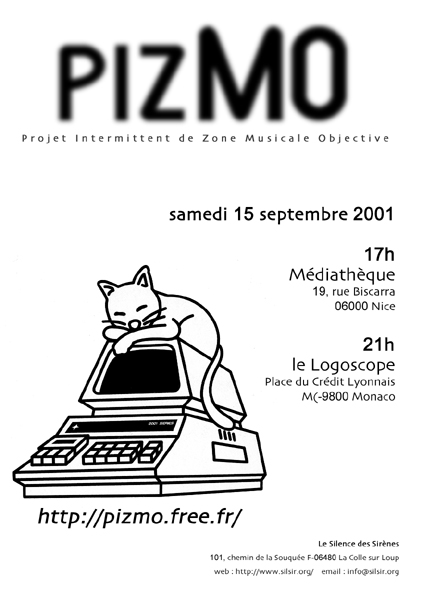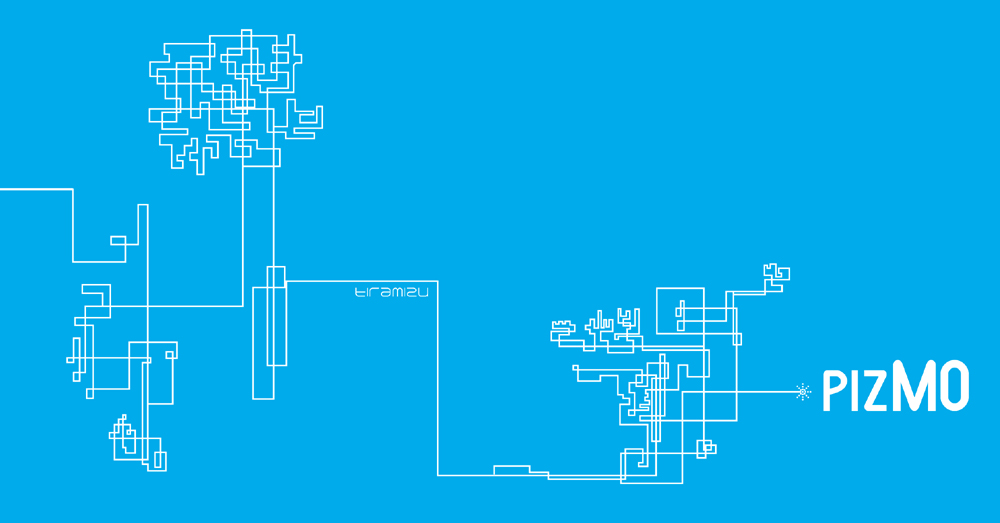User Tools
Sidebar
PIZMO
 Le projet du collectif pizMO est de développer des moments musicaux événementiels quasi-improvisés
et programmés à partir de dispositifs audio-numériques, électroniques et informatiques. Le concert
est pour eux une sorte de “campement” temporaire (free laptop party ou open audio streaming), une
interface momentanée de leurs activités en continu sur les réseaux et sur les médias qu'ils explorent
(radio, édition, p2p, streamings, etc.). Lors de ces événements, ils s'associent à des collectifs vidéo
temps réel.
PizMO, acronyme de Projet Intermittent de Zone Musicale Objective, gravite autour d'un maillage constitué
d'autres projets comme Formanex, Kalerne.net, collectivejukebox.org, radiolabo, picNIC, PacJap?, Apo33?,
Nomusic.org, Tiramizu, etc.
Le projet du collectif pizMO est de développer des moments musicaux événementiels quasi-improvisés
et programmés à partir de dispositifs audio-numériques, électroniques et informatiques. Le concert
est pour eux une sorte de “campement” temporaire (free laptop party ou open audio streaming), une
interface momentanée de leurs activités en continu sur les réseaux et sur les médias qu'ils explorent
(radio, édition, p2p, streamings, etc.). Lors de ces événements, ils s'associent à des collectifs vidéo
temps réel.
PizMO, acronyme de Projet Intermittent de Zone Musicale Objective, gravite autour d'un maillage constitué
d'autres projets comme Formanex, Kalerne.net, collectivejukebox.org, radiolabo, picNIC, PacJap?, Apo33?,
Nomusic.org, Tiramizu, etc.
http://pizmo.tk/ http://www.studionex.com/ http://jukebox.thing.net/labo.html
The project of the collective pizMO is to develop factual & event musical moments quasi-improvized and programmed starting from digital audio, electronic and data-processing devices. The concert is for them a kind of temporary “camping” (free laptop party or open audio streaming) - acapamentos -, a temporary interface of their non-stop activities on the networks and the medias which they explore (radio, edition, p2p, streamings, etc). During these events, they join friendly real time video collectives. PizMO, acronym of Intermittent Project of Objective Musical Zone, revolves around a grid made up of other projects like Formanex, Kalerne.net, collectivejukebox.org, radiolabo, picNIC, PacJap?, Apo33?, Nomusic.org, Tiramizu, etc.
……………….
evolutive system ……………….
audio network ……………….
computing and acoustics ……………….
mobile flux and research ……………….
audio- and multisensory space ……………….
ambient sampling duplication replication ……………….
sonic glitches and residual sounds ……………….
real-time and live results ……………….
performed and fixed sounds ……………….
political positions ……………….
social involvements ……………….
immaterial mutations ……………….
catalyst for cooperation ……………….
experimental strategies ……………….
creative backbone & ramifications ……………….
augmented and advanced workspace ……………….
lo- & hi-tech ……………….
free community manifesto ……………….
critical audio-lounge ……………….
listening groupware ……………….
music on the edge ……………….
multiple interfaces ……………….
build your tools! ……………….
minimal tools ……………….
experimenting_sharing ……………….
listen to digital artefacts ……………….
on-line workshop ……………….
open portable surfaces ……………….
ogg mp3 & free tools ……………….
send and receive exchanges ……………….
polytope and telemusic ……………….
electrola microsound demos ……………….
homestudio ……………….
rotomatic ……………….
gnutella & xanadu jukebox ……………….
mary had a little lamb ……………….
………………. ………………. ……………….
“ Using the powerful of intuition, innovation, and skill, we create experiences with music that aren't just heard, they're felt. We call what we do audio architecture. You'll call it amazing. ” (from Muzak)
………………. ………………. ……………….
microsounddronehomestudiosampleambientcomputergeneratedaudio
………………. ………………. ………………. history of pismo beach second history of pizmo beach third history of pizmo beach fourth history of pizmo beach fifth history of pizmo beach history of pizmo beach (doc) pismo beach today welcome to pismo beach a travel to pismo beach pismo chamber pismo beach on-line pismo bowl pismo powerbook pismo users group the weather there pismo dunes The Morning Wake-up Game
………………. ………………. ………………. The stereotype of the deaf listener, unfortunately, still exists. If you ask musicians what a deaf listener looks or sounds like, the answers will probably include 1) Uses sign language, 2) can hear everything with a hearing aid or cochlea implant, 3) probably has bad or different speaking skills, and 4) most probably will not be able to learn on par with their hearing peers. Even though in some cases, the above may true, in most cases only one of them may be true or all of them may be false. Regardless of what musicians think on the basis of little or no experience with deaf listeners, they must be prepared to recognize that difference of communication skills must be accommodated in order for each individual deaf listener to reach their full potential.
traduction: (babelfish) Le stéréotype de l'auditeur sourd, malheureusement, existe toujours. Si vous demandez à des musiciens à quoi ressemble ou réagit un auditeur sourd, les réponses incluront probablement 1) l'utilisation de la langue des signes, 2) peut entendre tout avec une prothèse auditive ou un implant de la cochlée, 3) a probablement une plus ou moins grande facilité à l'élocution, et 4) ne pourrait probablement pas écouter au même niveau ou les mêmes choses que les autres auditeurs. Quoique dans certains cas, ce qui précède puisse être rectifié, et que dans la plupart des cas seulement une de ces réponses peut être vraie ou toutes peuvent être fausses. Indépendamment du fait que les musiciens pensent sur la base de peu ou d'aucune expérience avec des auditeurs sourds, ils doivent être disposés à identifier que la différence des facilités de communication doit être adaptée afin que chaque auditeur sourd puisse atteindre son plein potentiel.
………………. ………………. ……………….
more infos on PIZMO here


